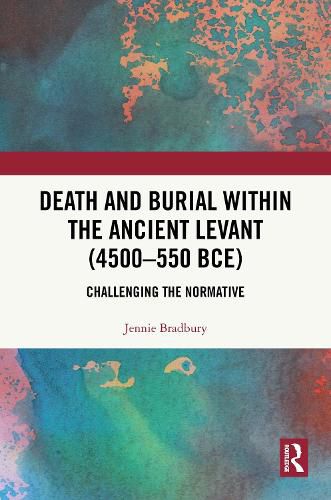Readings Newsletter
Become a Readings Member to make your shopping experience even easier.
Sign in or sign up for free!
You’re not far away from qualifying for FREE standard shipping within Australia
You’ve qualified for FREE standard shipping within Australia
The cart is loading…






This book offers a comprehensive survey of burial practices in the ancient Levant and challenges some of the assumptions behind previous attempts to find a normative burial practice.
Exploring the dazzling variety of ways in which the living deal with the dead, this book utilises big data projects and legacy data to highlight the sheer diversity of burial practices in the ancient Levant. Theorizing that some types of burial are significantly underrepresented, this volume argues for the necessity of analysing both the existing and non-existing data at multiple scales of analysis. Thus, rather than attempting to identify a 'normative' or 'typical' burial, the volume highlights the multitude of ways in which the living approached and interacted with the dead across the ancient Levant, from the Late Chalcolithic to the Iron Age (fifth to first millennia BCE). In doing so it acknowledges and foregrounds variability, not only in terms of so-called 'atypicality', but also in terms of burials and practices that have been mistakenly lumped together in the drive to produce narratives of similarity and normative behaviour. This volume also explores some of the broader patterns and temporal/spatial shifts that shed light on wider changes in the ways in which humans perceive(d) of the dead and themselves (the living) over time.
While predominantly focused on the modern regions of Israel, Jordan, Lebanon, Palestine, and Syria, this book also engages with these broader themes across Western Asia and the Mediterranean, adopting an interdisciplinary and cross-cultural approach to understanding temporal and spatial variability. This book is of relevance for students and researchers of Ancient Western Asia, as well as those of the archaeology of death and burial.
$9.00 standard shipping within Australia
FREE standard shipping within Australia for orders over $100.00
Express & International shipping calculated at checkout
This book offers a comprehensive survey of burial practices in the ancient Levant and challenges some of the assumptions behind previous attempts to find a normative burial practice.
Exploring the dazzling variety of ways in which the living deal with the dead, this book utilises big data projects and legacy data to highlight the sheer diversity of burial practices in the ancient Levant. Theorizing that some types of burial are significantly underrepresented, this volume argues for the necessity of analysing both the existing and non-existing data at multiple scales of analysis. Thus, rather than attempting to identify a 'normative' or 'typical' burial, the volume highlights the multitude of ways in which the living approached and interacted with the dead across the ancient Levant, from the Late Chalcolithic to the Iron Age (fifth to first millennia BCE). In doing so it acknowledges and foregrounds variability, not only in terms of so-called 'atypicality', but also in terms of burials and practices that have been mistakenly lumped together in the drive to produce narratives of similarity and normative behaviour. This volume also explores some of the broader patterns and temporal/spatial shifts that shed light on wider changes in the ways in which humans perceive(d) of the dead and themselves (the living) over time.
While predominantly focused on the modern regions of Israel, Jordan, Lebanon, Palestine, and Syria, this book also engages with these broader themes across Western Asia and the Mediterranean, adopting an interdisciplinary and cross-cultural approach to understanding temporal and spatial variability. This book is of relevance for students and researchers of Ancient Western Asia, as well as those of the archaeology of death and burial.